Story and photos by Shabna Ullah
Blairmont, West Bank Berbice which is divided into four settlements is well known as a sugar producing area and for providing employment for hundreds of persons at the Guyana Sugar Corporation (GuySuCo) estate. The predominantly East Indian community is bounded by Shieldstown to the right and Ithaca – the last village in West Berbice – to the left.
Many residents have squatted on the government reserve on the western side of the first three settlements and government was expected to upgrade it into a housing scheme. There is also the Zorg-en-Hoop Scheme on the western side of No 4 Settlement, but the scheme has been established about three lots away from the public road. It was also observed that the utility poles have been installed from that point, while a few squatters’ houses are located on the front lots.
Narine Kishorepersaud is one of the persons who has been squatting on the reserve with his family. He has been there for the past 28 years and has applied for the lot to be legalized. He learnt that the “matter is in parliament.” He operates a small vegetable stall in front of his home. That business was set up after he suffered a stroke which affected his right side about three years ago, and was unable to continue his work as a cane-harvester at the sugar estate.
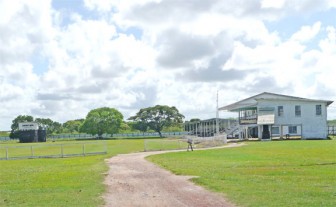
He was receiving sickness benefits until about one year ago when the estate deemed him fit to return to work. But he said he has not fully recovered from the stroke and cannot do strenuous work.
He mentioned that just before the Sunday Stabroek arrived, a car pulled up in front of his stall and a woman ordered two bags of vegetables from his wife. She was about pay with US currency and when he shouted at his wife to “be careful” the woman left everything and the car drove off.
Purandat Bissoondyal, a foreman at the estate, has been living in the Zorg-en-Hoop Scheme for the past three years and said he was happy that “it is fully developed. Government recently renovated the streets.”
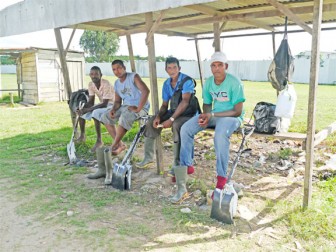
Bissoondyal, who described the people from the scheme as being “nice and friendly,” said the only problem was that “the scheme was not handed over to the NDC.”
He said too that “the NDC would do work but they don’t have full control. Government would make more revenue… I don’t know what they are waiting for.”
While the estate has provided employment for most of the residents, some persons have been engaged in other businesses such as sawmilling, snackettes, grocery stores and liquor restaurants. Some residents are also employed as
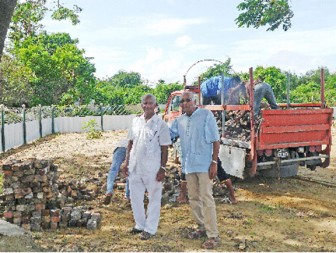
nurses, teachers and clerks.
Along with the sugar estate, the Blairmont Nursery and Primary Schools are located in the village as well as a Digicel tower, a Guyana Telephone &Telegraph outlet, a community centre, a sports club, the Neighbourhood Democratic Council office, a mosque, churches and mandirs.
Close to the sawmill is the ferry stelling belonging to the Transport & Harbours Department (T&HD) from where the launch, Miss Sonia used to operate and the estate’s wharf. Owner of the launch, Deonarine Mangal of Number 1 Settlement, was forced to shut down the
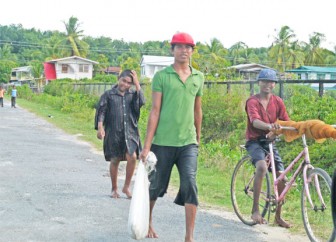
service almost two years ago. The business was no longer feasible after many chose to travel via the Berbice Bridge instead.
When this newspaper visited, a security guard attached to T&HD was sitting outside the door. There were two abandoned snackettes nearby that had been partly taken over by bushes. Close to the stelling was a water pump belonging to the estate, as well as a huge tank and the line for the locomotive that transports sugar from the factory to the wharf for export.
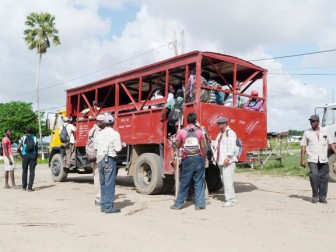
Residents who vend fruits and vegetables at the Rosignol Market on Saturdays complained that a bus would come from the Corentyne to sell bananas that had been imported from Suriname. They said that this is not fair because it was preventing the sale of the local bananas and called on the “relevant authorities to look into the matter as soon as possible.”
Rosy
Sitting on the stairs of an old, rickety, squatters house on the western side at No 3 Settlement was 25-year-old Rosy, who lived there with her mother and seven-year-old daughter. Life for Rosy is not
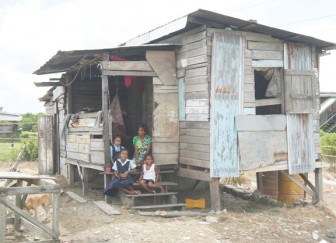
easy and she is struggling to get by. Her ‘child-father’ has deserted her and returned to the North West. Rosy who appears feeble does not earn a living. She depends on the income from her mother who begs from village to village. During this newspaper’s visit, her mother had already completed her job for the day and was resting in a hammock on the landing.
Her daughter and two nieces, aged five and seven were sitting on the stairs with her enjoying their fried ochro and rice that she cooked for lunch. The two older girls were preparing to return to the Blairmont Primary School while the younger of her nieces attends the Blairmont Nursery.
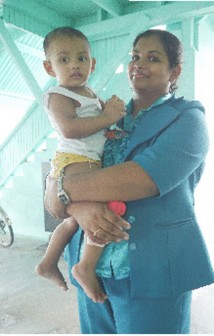
Her nieces and their other siblings live at No 1 Settlement and told this newspaper that they would go with their mother to beg sometimes. Their father recently underwent surgery and was resting at home.
Opposite their home, Showkatallie, a retired field foreman was busy taking care of his 11-month-old grandson, Daniel. The baby’s mother, Sheriza Lakeram of No 1 Settlement who has been working at the estate as a junior book-keeper/wages clerk for the past seven years had gone to the home for lunch so she can check on him and her daughter, Gloria, 6.
Allie left to drop Gloria off to school on his bicycle while Lakeram spoke to the Sunday Stabroek. She worked at Guyana Stores Ltd in New Amsterdam as a secretary for three years but had found the work to be stressful, with “more workload and no raise of pay.” The work at the estate, she said, is “hassle-free and close to home.”
Her husband is also employed at the estate in the factory and the two would normally go to her parents’ home for lunch on his motorcycle. Her father returned from school and by then she was ready to leave. Her mother was not home that day.
Allie who served GuySuCo for 45 years, retired as a field foreman from Blairmont estate three years ago. He had also worked a few years at the Rose Hall estate. The man who “grew up in the village” recalled that it was “like a ghost-town… in those days we had red road.” Government later helped to develop the area. He said the estate gave his father and other workers house-lots and they built small camps for their families until they earned enough money to construct nicer houses.
A lot of residents have migrated and left persons to live in their houses and take care of them while others have locked up theirs.
Allie said “Blairmont is a wonderful place to live… When you are accustomed to a place you cannot live anywhere else.” They only thing, he said is that “we would have fights here when persons drink and sometimes we would have petty thieves.” He said proudly that his two sons, Alim and Intikaf Showkatallie were national volleyball players.
Alim who formerly worked as a fitter machinist at the estate now lives in Florida with his family, while his other son, Intikaf, who works on a tourist ship was employed at the estate as a welder.
At No 2 Settlement, Vidawaty Reautiraman, a housewife, who had gotten up at 5 am to start her chores was relaxing in her hammock.
She also sells snacks and was waiting for the schoolchildren to come over and make their purchases. The woman who is originally from Glasgow, East Bank Berbice, has five children and 12 grandchildren.
Crematorium
A resident, Nowrang Persaud, a consultant with the United Nations in East Africa and Asia who has to be away very often on overseas assignments, is overseeing the establishment of the Blairmont Crematorium and Memorial Garden (BCMG). Persaud who serves as President of BCMG said the facility, the first of its kind in West Berbice would have a seating capacity in a pavilion of about 200.
Trees have already been planted and according to him, these would provide “accommodation and shade for about 20 persons.” There would also be refreshments, washroom and other facilities.
He emphasized that “the facility would serve as both a crematorium and a garden society.
Bringing the two together is symbolic of the cycle of life and death…”
“The cremation reminds you that there is life in the form of the flower and the trees and that would dominate the ambience.” He said too: “It would be open to the general public, primarily those living in West Berbice and persons can hold memorial services” on special occasions like Mother’s Day.
The idea for the crematorium was conceived a few years ago when his mother died and it struck him that “they had to fetch the dead a long way and stand in the sun for a long time. And there was no bathroom facility.” Since then he “attended a few more cremations and the idea of establishing the facility became a burning obsession. But because I was more out than in on different UN assignments it wasn’t possible.” This year he has “decided to suspend all overseas assignments and focus completely on getting the job done.”
The land was acquired through a deed of gift from GuySuCo and was cleared and filled. It has already been fenced with most of the materials being donated by Toolsie Persaud Ltd. Persaud said too that “some of the rice farmers from Cotton Tree were generous in their support in terms of providing the sand at discount prices, and making their [machinery] available to work.”
During this newspaper’s visit he had just gotten back from the Wales Sugar Estate with “clay bricks to build the two pyres,” and workers were offloading them from a truck. He said persons who built the Ruimzigt crematorium had offered to supervise the construction of the pyres, while a contractor from Cotton Tree has dedicated his services to constructing the pavilion.
Although the “project is having good corporate support we are trying to raise funds through a raffle [at $500 per chance]” with five airline tickets up for grabs.
Persaud who “grew up at Blairmont” attended the primary school which was close to the sugar estate.
A mandir and mosque were also located nearby. He recalled that “after the Sugar Industry Labour and Welfare Fund was established all the logies were cleared and houses were built.”
He worked on the estate as a labourer and then “won a scholarship in the Booker days with the inspiration of Dr Jagan – these were awarded to the bright young men. I did a degree in management in London.” He was appointed personnel manager at Blairmont and also served at Wales, Rose Hall and LBI estates. After migrating to Canada in the 1970s he worked with the Canadian government, then got an offer to join the UN as a professional member of staff in the field of Human Resources management. “I took early retirement when my parents died and I returned and worked as a director of Human Resources at GuySuCo for four years, then at DDL for five years.”
According to him, “Blairmont is one of the best estates. It was owned by the Davson family before Bookers took over and then became nationalized as part of GuySuCo.





